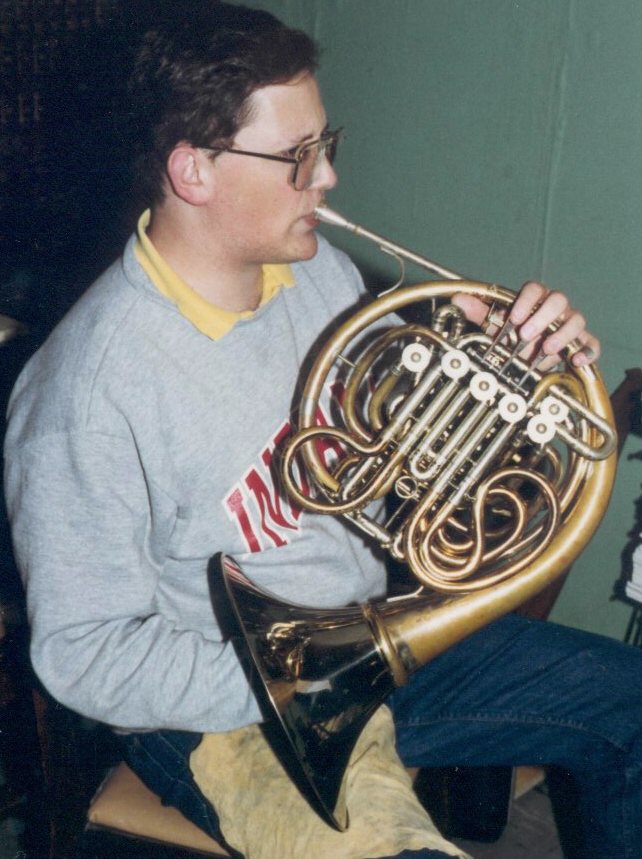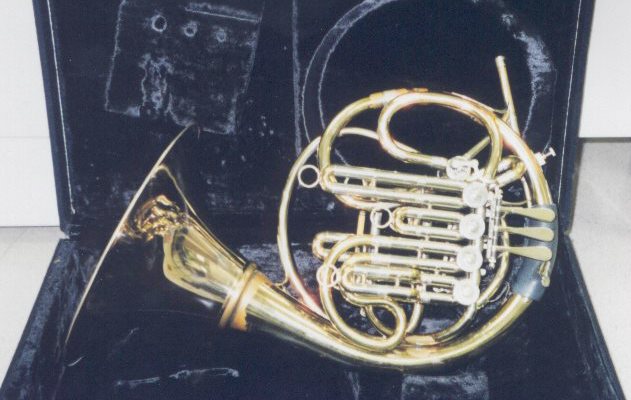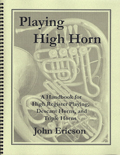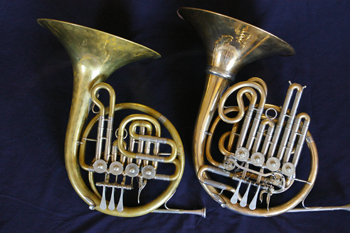
Horn Articles Online
Playing Descant and Triple Horns
What is a descant horn?
Although they are made in other keys, the vast majority today are produced as
double horns in B-flat/high F. They are made to stand in B-flat, the same B-flat as on a double horn, but when you put the thumb valve down the instrument goes to high F an octave shorter than the low F on a double horn. Thus the descant horn has a more secure high range than the double horn and is of great use in high horn playing.
I have performed professionally many times on descant horn in orchestral and solo situations. Drawing on this experience I wrote one of the only articles that has ever been published on the descant horn, which appeared in the May, 2001 issue of The Horn Call, "Playing the Descant Horn," and incorporated the text into my book on high horn playing. More on that in a moment.
Two instruments of mine that I used frequently at the time of writing
that book are illustrated at the top left of this page, both by Paxman. On the left is a older model descant in B-flat/high F and the other is a model 83 compensating triple in F/B-flat/high F.
What is a triple horn?
The triple horn can be thought of as a combination of a double horn and a descant horn.
Essentially it is a double horn with a high F side available -- or a
descant horn with a low F side available.
Turning again to the photo above, although the horn at the above right looks a lot like a descant, it is in fact a compensating triple -- a horn not often seen in the USA. Most commonly triples are constructed as a "full" triple in F/B-flat/high F.
I prefer triple horns to "stand" in low F, as do most players using these instruments in the United States. This is because for us double horns normally stand in F; set up in this manner the triple will operate very much like a double horn with a descant "on top."
 When should I start playing descant or triple horn?
When should I start playing descant or triple horn?
I was aware of them when I was in high school but I started playing them as an advanced grad student. The time to
really start learning about descant and triple horns is in that time frame when you are getting serious about auditions and winning a job.
Practically every full time high horn player owns either a descant or triple horn and many own both. These instruments are not a way to "cheat." They are tools that used wisely can only enhance your ability to play difficult horn parts with freedom and artistry.
In my own case, as a grad student at Eastman and then later Indiana University, I was working very hard and had made the finals for auditions but there were still certain high horn excerpts that were causing me trouble. One particular audition for principal horn in Columbus in the late 1980s was a key one for me in terms of equipment. It was a bit of an odd audition as they advanced only one player, me (!), to the semi-finals. In those semi-finals they asked me to play the excerpt from Haydn 31 that goes up to the high C-sharp. At the time I was playing a 500,000 series Conn 8D. It was really not the right horn for that excerpt, and I did not win the job.
 The first instrument I owned with a high F side was the instrument above,
purchased shortly after that audition, a Paxman full triple made in
December of 1967. I did not know it at the time, but it was actually the
first triple horn produced by Paxman! There were things about the horn I
liked (that is a much younger me holding it in the photo above, taken by my dad),
the high range was really quite nice, but it was also quite heavy and the low range was rather stuffy.
I recall enjoying the horn a great deal playing first horn on Mahler 9,
but eventually I became afraid of the low range after using it to perform
second horn on a series concert on it in the Evansville Philharmonic. I
could not use that particular horn for my general playing was a bottom
line.
The first instrument I owned with a high F side was the instrument above,
purchased shortly after that audition, a Paxman full triple made in
December of 1967. I did not know it at the time, but it was actually the
first triple horn produced by Paxman! There were things about the horn I
liked (that is a much younger me holding it in the photo above, taken by my dad),
the high range was really quite nice, but it was also quite heavy and the low range was rather stuffy.
I recall enjoying the horn a great deal playing first horn on Mahler 9,
but eventually I became afraid of the low range after using it to perform
second horn on a series concert on it in the Evansville Philharmonic. I
could not use that particular horn for my general playing was a bottom
line.
It was replaced with this Holton descant, which served me well in auditions and when I performed third horn in Nashville. In this period I used the descant only for certain works; I primarily performed on double horn, using the descant generally for higher, lighter works. Queen Mab is wonderful on a descant!
Jumping ahead to more recent years, I subsequently purchased a Paxman compensating triple that was ideal for big works when I was playing principal horn at Brevard, and upgraded to a vintage Paxman descant. As I rarely play principal on big works now the triple is no longer in my hands, but I really enjoy the descant for works where I want a lighter sound, such as Baroque concertos.
For me personally, in the end, for general playing and teaching horn a double horn is my main instrument. However, for sure there is a place for all three types of horns in the music performed by horn players today.
Descant and triple horns are topics that I always cover with advanced students in the ASU horn studio. It is also a topic that, along with high horn playing, about which very little has been published. This fact led me to write a book (originally published in 2007 as Playing High Horn), and then revise it extensively into the publication featured below:
 Playing
Descant and Triple Horns: An Introduction to the use of Descant and Triple Horns
Playing
Descant and Triple Horns: An Introduction to the use of Descant and Triple Horns
A practical introduction to descant and triple horns, tools available to the modern hornist for more secure high range performance. This volume covers many topics related to these instruments including fingerings, mouthpiece choices, and music to study and perform, while also touching on the history of the instruments. This second edition includes expanded coverage related to high range production along with tips and excerpts from important solos and orchestral works.
Available from Horn Notes Edition | Print version -- Kindle version
 BONUS ARTICLE:
BONUS ARTICLE:
The Little Descants
Not commonly seen today, this article is an online exclusive tribute to early descant horns. Instruments of this type are around and still worth investigating.
There is a time coming soon when every serious, advanced horn student owns a descant or triple horn, much as every serious trumpet, trombone, or tuba student owns several instruments at different pitch lengths that they use in different works.
The days have passed when a professional horn player, especially a professional high horn player, can own just one horn. Don't be the last one to learn about these instruments and check out the new version of my high horn book at www.hornnotes.com
Return to Horn Articles Online